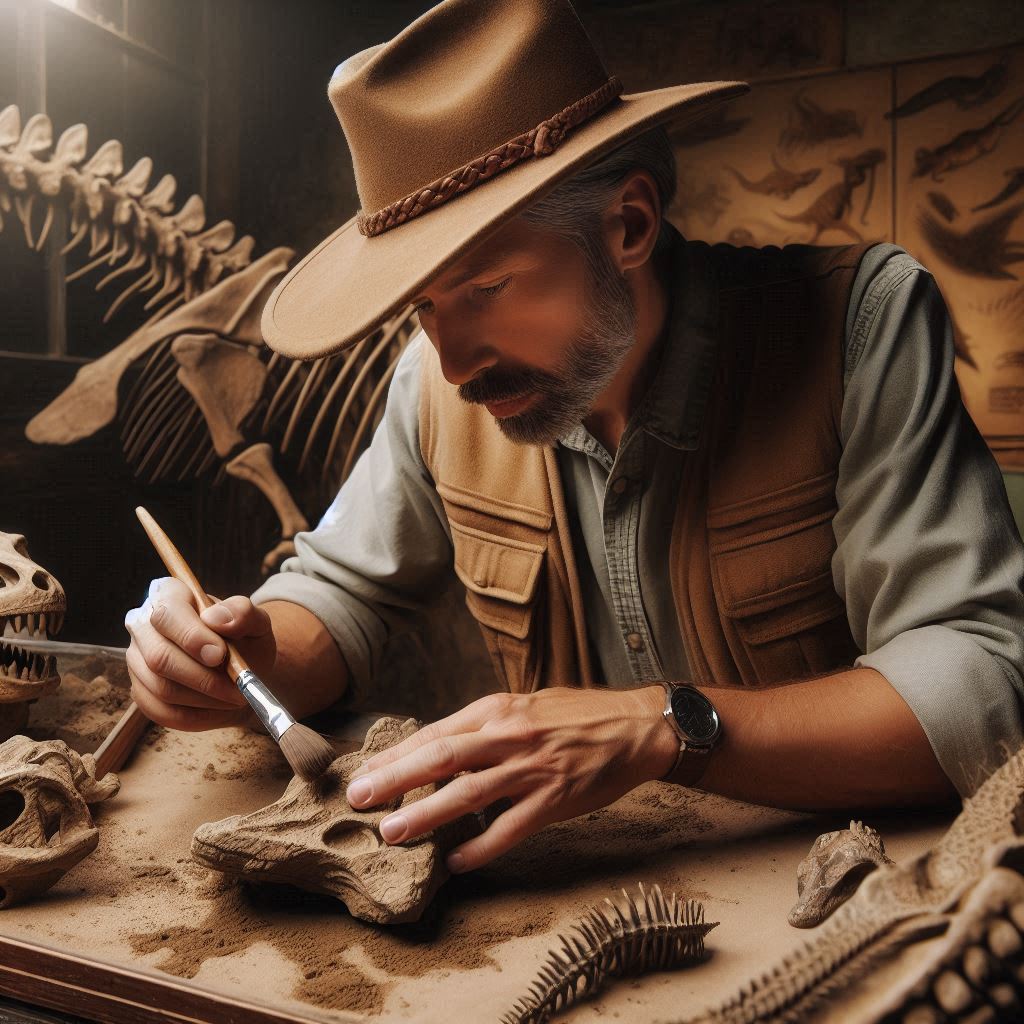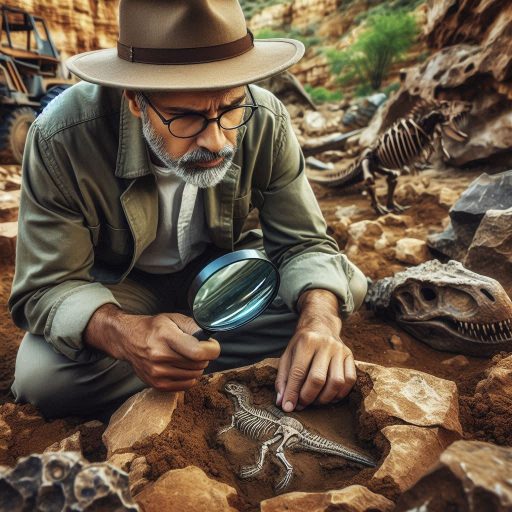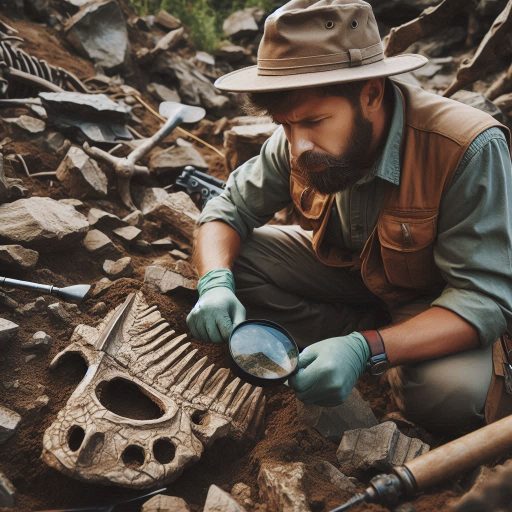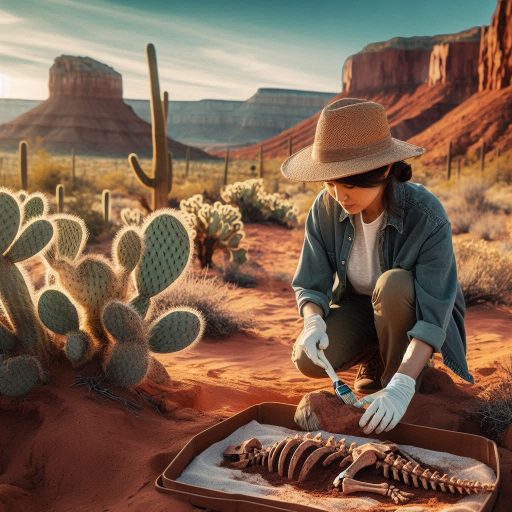Introduction
Building a professional network in paleontology is crucial for career advancement and personal growth.
A robust network fosters connections with other professionals, enhancing knowledge and skills in the field.
Engaging with fellow scientists, researchers, and students opens doors to new opportunities, such as internships, research positions, and job offers.
Attending conferences and workshops is an excellent way to meet experts and fellow enthusiasts.
These events provide an environment for meaningful discussions and collaborations that can lead to significant research projects.
Participants can share their findings, learn about the latest advancements, and receive feedback from their peers.
Networking in such settings often leads to partnerships that enrich one‘s research endeavors.
Joining professional organizations is another effective strategy for expanding your network.
Organizations such as the Paleontological Society and the Society of Vertebrate Paleontology offer access to valuable resources, mentorship programs, and networking opportunities.
Membership often includes newsletters, journals, and invitations to exclusive events, which further enhance professional development.
Engaging with peers through social media platforms, such as LinkedIn and Twitter, helps maintain and grow connections over time.
By sharing research updates, articles, and insights, you can attract attention from potential collaborators and employers.
These platforms enable you to showcase your expertise and stay informed about industry trends and events.
Understand the Paleontology Community:
Research Different Organizations, Conferences, and Online Platforms Related to Paleontology
Building a professional network in paleontology begins with thorough research.
Start by identifying key organizations dedicated to paleontology.
Groups like the Society of Vertebrate Paleontology offer valuable resources and networking opportunities.
Joining these organizations can provide access to their events and resources.
Next, look for conferences focused on paleontology.
Conferences serve as excellent venues for meeting professionals in the field.
Events such as the annual meeting of the Geological Society of America attract many paleontologists.
Attend these gatherings to gain insights into current research and network with peers.
Online platforms also play a crucial role in networking.
Websites like ResearchGate and LinkedIn connect professionals across various disciplines.
Create a strong profile showcasing your interests and expertise in paleontology.
Engaging with posts and sharing your research can attract attention from other professionals.
Additionally, follow paleontology-related hashtags on social media platforms.
Twitter and Instagram are great places to discover discussions about paleontological topics.
Participate in these conversations to increase your visibility and connect with like-minded individuals.
Social media can help you stay informed about industry news and events.
Key Players and Influencers in the Field to Connect With
As you research organizations and events, identify key players and influencers in paleontology.
Look for prominent paleontologists who contribute significantly to the field.
Reading their publications and following their work can deepen your understanding of current trends.
Knowing their areas of expertise will help you engage meaningfully in conversations.
Once you identify these individuals, consider reaching out.
Send polite and concise messages expressing your admiration for their work.
Mention specific papers or projects that inspired you.
This personalized approach increases the likelihood of a positive response.
Networking does not have to be intimidating.
Start by engaging with their posts on social media.
Comment thoughtfully on their work and share relevant insights.
Building rapport online can pave the way for more substantial interactions.
Consider attending lectures or workshops featuring these influencers.
Many professionals participate in outreach activities at universities and museums.
Attending these events provides opportunities to introduce yourself and discuss shared interests.
Personal interactions can lead to lasting connections.
Finally, keep track of your interactions and follow up.
Maintaining relationships is crucial for building a professional network.
Send occasional messages to check in or share relevant updates.
This approach shows that you value the connection and are committed to nurturing it.
Attend Paleontology Events
Attend Conferences, Workshops, and Seminars to Meet Professionals in Person
Building a professional network in paleontology starts with attending conferences, workshops, and seminars.
These events offer valuable opportunities to meet experts and peers.
They provide a platform for sharing knowledge and discussing the latest research.
Conferences often feature keynote speakers, panel discussions, and poster presentations.
Attending these sessions allows you to learn from leaders in the field.
You can gain insights into current trends and discoveries.
Workshops offer hands-on experiences, enhancing your skills while fostering connections with fellow participants.
Networking at these events is crucial for building relationships.
Approach fellow attendees and introduce yourself with confidence.
Prepare a brief introduction that highlights your interests and background in paleontology.
Share your goals and ask others about their experiences.
Don‘t hesitate to engage with speakers after their presentations.
Express your appreciation for their work and ask insightful questions.
This shows your genuine interest in their research and opens the door for further conversations.
Follow up with a friendly email or message after the event.
This helps solidify the connection and leaves a lasting impression.
Engage in Discussions and Ask Questions to Show Genuine Interest in the Field
Engaging in discussions is essential for networking in paleontology.
Approach conversations with curiosity and enthusiasm.
Listen actively to others and contribute your thoughts on the topic.
This creates a collaborative atmosphere and encourages others to share their experiences.
Asking questions is a powerful way to demonstrate your interest.
Inquire about specific research projects or methodologies.
Seek advice on career paths or academic pursuits.
Most professionals appreciate when someone values their expertise and seeks guidance.
Participate in group discussions or breakout sessions at events.
These smaller settings allow for more intimate conversations and deeper connections.
Share your insights and experiences, and encourage others to do the same.
This fosters a supportive community and promotes collaboration among peers.
Join online forums or social media groups related to paleontology.
Participate in discussions, share resources, and ask questions.
This expands your network beyond local events and connects you with professionals worldwide.
Engaging online allows you to build relationships with individuals who share your passion.
Consider volunteering for paleontological organizations or research projects.
This hands-on experience not only builds your skills but also introduces you to professionals in the field.
Collaborating with others fosters teamwork and deepens your understanding of the discipline.
Therefore, building a professional network in paleontology requires active engagement.
Attend conferences, workshops, and seminars to meet professionals in person.
Participate in discussions and ask questions to show your genuine interest in the field.
These efforts will enhance your knowledge and help you establish meaningful connections.
By nurturing these relationships, you can create a supportive network that benefits your career in paleontology.
Read: Day in the Life: An Environmental Scientist‘s Typical Day
Utilize Online Networking Platforms
Create a LinkedIn Profile and Join Paleontology Groups
Building a professional network in paleontology starts with an effective LinkedIn profile.
Create a compelling profile that highlights your education and experiences.
Include relevant keywords related to paleontology in your summary and skills sections.
This approach increases your visibility in searches by recruiters and peers.
Joining paleontology groups on LinkedIn connects you with like-minded professionals.
These groups serve as platforms for sharing ideas and experiences.
Participate actively in discussions to showcase your knowledge and passion for the field.
Engaging with other members can lead to valuable connections and collaborations.
Follow industry leaders and organizations to stay updated on the latest trends.
This practice helps you learn from established professionals.
It also allows you to engage with their content, increasing your visibility within your network.
When you comment on or share their posts, you demonstrate your interest and expertise.
Additionally, customize your LinkedIn URL to make it more professional.
A clean URL enhances your online presence and makes sharing easier.
Consider adding this URL to your resume and email signature to promote your profile further.
Share Relevant Articles, Research, and Insights to Showcase Your Expertise
Once your profile is set up, begin sharing relevant articles and research.
Sharing content demonstrates your engagement with current paleontological trends and topics.
This action shows others that you are knowledgeable and passionate about your field.
Choose articles that resonate with your interests or reflect ongoing research.
You can also write your own posts or articles.
Discuss recent discoveries, advancements in technology, or new research methods.
This original content showcases your expertise and contributes to the community.
Aim to provide insights or opinions that spark discussions among your network.
When you share articles, include a brief summary or your perspective.
This addition encourages others to engage with your posts.
Ask questions or invite feedback to stimulate conversations.
Active engagement builds your reputation as a knowledgeable and approachable professional.
Additionally, consider participating in online webinars or workshops.
Many organizations offer virtual events that allow you to learn and network.
Share your experiences from these events on your LinkedIn profile.
This practice reinforces your commitment to professional growth and networking.
Don‘t forget to connect with your peers after meeting them at conferences or workshops.
Sending personalized connection requests helps solidify these new relationships.
Mention your shared experiences or interests to create a meaningful connection.
Basically, building a professional network in paleontology involves creating a robust LinkedIn profile and actively participating in relevant groups.
Sharing articles and insights showcases your expertise and passion.
By engaging with others in your field, you cultivate relationships that can enhance your career.
Embrace these networking opportunities to grow both personally and professionally in paleontology.
Read: The Impact of Technology on the Chemist Profession in the US
Collaborate on Research Projects
Reach Out to Researchers and Professors to Inquire About Potential Collaborations
Building a professional network in paleontology requires proactive engagement.
Start by reaching out to researchers and professors in your field.
Introduce yourself and express genuine interest in their work.
Personalizing your communication demonstrates your enthusiasm and dedication.
Most researchers appreciate hearing from passionate individuals.
You can utilize academic platforms like ResearchGate or LinkedIn for this outreach.
These platforms allow you to connect with professionals and follow their work.
Share insights from their publications or ask thoughtful questions.
This approach encourages meaningful conversations and opens doors for collaboration.
Attend conferences, workshops, and seminars to meet professionals face-to-face.
Networking at these events enhances your visibility in the community.
Prepare a concise elevator pitch about your background and interests.
This preparation helps make a lasting impression when you introduce yourself.
Don‘t hesitate to inquire about potential collaborations.
Many researchers welcome fresh perspectives and ideas.
Offer to assist in their projects, as this can lead to valuable experiences.
By showing initiative, you position yourself as an engaged and resourceful collaborator.
Offer Your Skills and Expertise to Contribute to Ongoing Projects in the Field
Offering your skills and expertise is crucial for building your professional network.
Identify areas where you can contribute effectively.
For instance, if you have experience with data analysis, offer to help analyze research findings.
Researchers often seek individuals with specific skill sets to enhance their projects.
Collaborating on projects allows you to demonstrate your abilities.
As you work together, you develop relationships built on shared goals and mutual respect.
These connections often lead to further opportunities in the future.
Building a reputation as a reliable team member can significantly impact your career.
Consider volunteering for research projects or fieldwork initiatives.
Many organizations seek enthusiastic volunteers to assist with various tasks.
By contributing your time and skills, you gain practical experience while expanding your network.
You also show your commitment to the field, which can resonate with established professionals.
Participating in local paleontological societies can also enhance your networking efforts.
These groups often organize events and activities where members can connect.
Attend meetings, participate in discussions, and actively engage with other members.
By getting involved, you create lasting relationships with peers and mentors.
In review, building a professional network in paleontology requires initiative and active participation.
Reaching out to researchers and professors fosters potential collaborations.
By offering your skills and expertise, you contribute to ongoing projects and demonstrate your value.
Engage in face-to-face interactions at conferences and local societies to solidify these connections.
Networking plays a crucial role in your career development, opening doors to new opportunities in the field of paleontology.
Read: Essential Skills and Tools for Modern Chemists in America

Volunteer for Paleontology Organizations
Volunteer for Museums, Fossil Digs, or Research Expeditions to Gain Hands-On Experience
Building a professional network in paleontology starts with volunteering.
Seek opportunities at museums, fossil digs, or research expeditions.
These experiences offer invaluable hands-on learning and exposure to the field.
Museums often look for enthusiastic volunteers to assist with exhibits or educational programs.
By volunteering, you can gain practical skills and enhance your resume.
Fossil digs provide unique chances to work directly with fossils.
Participating in these digs allows you to learn excavation techniques.
You will also familiarize yourself with proper fossil handling and documentation.
Research expeditions enable you to assist professionals in various scientific tasks.
This hands-on experience strengthens your understanding of paleontological methods and theories.
When you volunteer, you connect with others who share your passion.
Many professionals in the field start as volunteers, fostering a welcoming environment.
This shared interest creates opportunities for collaboration and mentorship.
You will meet paleontologists, researchers, and students who can influence your career path.
These connections can lead to future internships or job opportunities.
Build Relationships with Professionals in the Organization and Learn from Their Expertise
While volunteering, focus on building relationships with professionals in the organization.
Approach them with questions about their work and experiences.
Show genuine interest in their research and projects.
Many professionals appreciate the enthusiasm of eager learners.
This interaction lays the groundwork for valuable connections.
Participating in discussions and activities within the organization fosters stronger relationships.
Attend workshops, lectures, and events organized by the museum or institution.
Engaging in these settings allows you to meet a variety of professionals.
It provides a platform for you to share your interests and goals.
Networking is not just about gaining contacts; it‘s about learning.
Ask for advice on entering the field or developing skills.
Many professionals are willing to share their insights and experiences.
This exchange of knowledge can help you navigate your career in paleontology.
Moreover, it can lead to potential mentorship opportunities, which can be incredibly beneficial.
Utilize social media to maintain and expand these connections.
Follow professionals on platforms like LinkedIn and Twitter.
Engage with their posts by liking, sharing, and commenting.
This shows your continued interest in their work and keeps you on their radar.
You can also share your volunteer experiences, showcasing your commitment to the field.
In review, volunteering at museums, fossil digs, and research expeditions is essential for building a professional network in paleontology.
This hands-on experience provides practical skills and valuable connections.
Focus on building relationships with professionals in the organization to enhance your learning.
By engaging actively, you can gain insights and potential mentorship.
Networking in paleontology is a journey, and every connection can lead to new opportunities and experiences.
Read: The Role of Chemists in US Environmental and Sustainability Efforts
Learn More: The Role of Soil Scientists in Urban Gardens
Discover More: What Do Astronomers Do? A Day in the Life
Establish Mentorship Relationships
Seek Out Experienced Professionals in Paleontology to Mentor You
Building a professional network in paleontology starts with seeking out experienced mentors.
These individuals can provide valuable insights and guidance throughout your career.
Mentorship offers opportunities to learn from those who have successfully navigated the field.
Many professionals are willing to share their knowledge and expertise with eager learners.
To find a mentor, start by attending paleontological conferences and workshops.
These events attract experienced professionals from various backgrounds.
Engage with speakers and participants to express your interest in paleontology.
Introduce yourself, share your goals, and ask for advice.
Most people appreciate the initiative and may be open to mentorship.
Utilizing online platforms can also help you connect with potential mentors.
Websites like LinkedIn allow you to search for professionals in the field.
Join paleontology-related groups and participate in discussions.
Reach out to individuals whose work you admire and ask for guidance.
A well-crafted message can lead to meaningful connections.
Learn from Their Experiences, Ask for Advice, and Build a Long-Lasting Relationship
Once you find a mentor, approach the relationship with respect and curiosity.
Ask thoughtful questions about their career journey and experiences.
Inquire about challenges they faced and how they overcame them.
This knowledge can be invaluable as you navigate your own path in paleontology.
When seeking advice, be open to constructive criticism.
Your mentor may provide insights that challenge your perspective.
Embrace these opportunities for growth and development.
Their feedback can help you refine your skills and enhance your understanding of the field.
Regular communication is essential for building a strong mentor-mentee relationship.
Schedule periodic check-ins to discuss your progress and seek further guidance.
These conversations foster a deeper connection and demonstrate your commitment to the relationship.
Consistent communication also keeps you on their radar, opening doors for future opportunities.
In addition to seeking advice, offer to assist your mentor in their projects.
This collaborative approach can strengthen your bond and showcase your dedication.
Contributing your skills and time can also enhance your learning experience.
Engaging in joint projects allows you to apply your knowledge and gain practical experience.
As you build this relationship, express gratitude for their support.
A simple thank-you note can go a long way in acknowledging their help.
Celebrate milestones together and share your successes.
This positive reinforcement fosters a mutually beneficial relationship.
Networking within paleontology extends beyond finding a mentor.
Attend seminars, workshops, and fieldwork events to meet other professionals.
Engage in discussions and share your interests with others in the field.
Building a diverse network will enhance your career and provide a wealth of resources.
Discover More: Nuclear Science Projects for Students
Transform Your Career Today
Unlock a personalized career strategy that drives real results. Get tailored advice and a roadmap designed just for you.
Start NowDiscover More: The Role of Anthropologists in Modern Society
Follow Up and Stay Connected
After Networking Events, Follow Up with a Personalized Email or Message
Building a professional network in paleontology requires intentional actions after networking events.
Following up is crucial to solidifying the connections you make.
After meeting someone, send a personalized email or message within a few days.
This timely follow-up shows your interest and appreciation for their insights.
In your message, mention something specific from your conversation.
This detail will help them remember you and your discussion.
Acknowledging their expertise or expressing gratitude for their advice fosters goodwill.
Personalizing your message makes it clear you value the connection.
Include a brief reminder of who you are.
Mention where you met and highlight any shared interests.
This approach keeps the conversation relevant and helps maintain rapport.
Additionally, feel free to share resources or articles related to your discussion.
This demonstrates your commitment to continued learning and engagement in the field.
Furthermore, consider suggesting a future meeting or coffee chat.
This invitation allows for deeper conversations and strengthens your relationship.
Many professionals appreciate the opportunity to connect further, especially if you share similar interests or career goals.
Even a virtual meeting can be effective in building rapport.
Stay Connected by Sharing Updates and Maintaining Regular Communication with Your Professional Contacts
Once you’ve established connections, staying engaged is essential.
Regular communication keeps you on their radar and reinforces your professional relationship.
Share updates about your work, research, or projects you are involved in.
By doing this, you provide insight into your growth and interests.
Use social media platforms like LinkedIn to maintain connections.
Posting updates about your achievements or relevant articles keeps your network informed.
Engaging with their posts by commenting or sharing is another way to stay connected.
This interaction shows you care about their work and opinions.
Additionally, consider organizing or participating in informal meetups with your contacts.
A simple gathering can encourage discussion and networking among peers.
These interactions can lead to valuable collaborations and insights into the industry.
Creating a supportive network of peers can foster personal and professional growth.
Moreover, don‘t hesitate to ask for advice or guidance.
Reaching out for insights shows that you value their expertise.
Many professionals appreciate being asked for their opinion, as it reinforces their authority in the field.
Remember to reciprocate by offering help whenever possible.
In closing, always express gratitude for any support or assistance you receive.
A simple “thank you” can go a long way in building rapport.
Cultivating a network is a two-way street, and showing appreciation fosters lasting relationships.
Conclusion
In this blog, we explored effective strategies for building a professional network in paleontology.
Networking is a vital aspect of career development and can open doors to numerous opportunities.
We discussed attending conferences, workshops, and seminars as key opportunities to meet fellow professionals and learn about the latest research in the field.
Engaging in these events allows you to connect with established paleontologists and share your interests and expertise.
Furthermore, we emphasized the importance of joining relevant organizations and associations that connect paleontologists.
These groups often provide access to valuable resources, mentorship opportunities, and collaborative projects that can enrich your career.
Participating in these organizations helps you stay informed about industry trends and developments.
Utilizing online platforms like LinkedIn is another effective way to enhance your visibility in the field.
Creating a strong online presence allows you to showcase your skills and research while connecting with professionals from around the world.
Sharing your work, insights, and experiences can attract attention and foster meaningful connections.
Nurturing relationships through regular communication and follow-ups helps maintain connections over time.
Whether it’s sending a quick email to share an interesting article or inviting colleagues for coffee, consistent engagement reinforces your professional ties.




